Corrections Corporation of America Announces Second Quarter 2009 Financial Results
Second Quarter EPS of $0.28, or $0.30 Excluding Refinancing Charge Raises Full-Year 2009 EPS Guidance to a Range of $1.21 to $1.26
NASHVILLE, Tenn. - August 5, 2009 - Corrections Corporation of America (NYSE: CXW) (the "Company" or "CCA"), the nation's largest provider of corrections management services to government agencies, announced today its financial results for the second quarter ended June 30, 2009.
Financial Review - Second Quarter 2009
- Revenues increased 5.7% with increases in inmate populations of 3.4% and average per diem rates of 2.3%
- Earnings per diluted share (EPS) of $0.28
- EPS excluding expenses associated with debt refinancing transactions, net of taxes, (Adjusted EPS) of $0.30
- State of California populations increased from 6,647 to 7,884 during the second quarter of 2009
- Awarded an amendment to an existing contract to expand two of our facilities in Georgia to house up to 1,500 additional inmates
- Completed offering of $465.0 million aggregate principal amount of new 7.75% senior notes, maturing in June 2017
- Purchased or redeemed our outstanding $450.0 million 7.5% senior notes due in May 2011
For the second quarter of 2009, CCA generated net income of $32.6 million, or $0.28 per diluted share, compared with net income of $37.5 million, or $0.30 per diluted share, for the second quarter of 2008. Results for the second quarter of 2009 included a charge of $3.8 million, or $0.02 per diluted share after taxes, associated with the debt refinancing transactions further described below. Excluding the expenses associated with debt refinancing transactions, we generated net income of $35.0 million, or $0.30 per diluted share, for the second quarter of 2009.
Total revenues for the second quarter of 2009 increased 5.7%, primarily driven by a 2.3% increase in revenue per compensated man-day combined with a 3.4% increase in average daily inmate populations. Management revenue from state customers increased 8.2% to $216.8 million during the second quarter of 2009 from $200.3 million for the same period in 2008. The growth in state revenue from the second quarter of 2008 was primarily attributable to a combination of increased inmate populations and increases in average per diems. Our results reflect increases in inmate populations from California and Arizona that were partially offset by a reduction in inmate populations from the states of Minnesota, Washington and New Mexico. Management revenue from federal customers increased 3.6% to $162.2 million generated during the second quarter of 2009, compared with $156.5 million generated during the second quarter of 2008, driven by a combination of higher per diem rates and inmate populations.
Operating income during the second quarter of 2009 increased to $74.9 million compared with $74.0 million for the prior year period. Adjusted EBITDA for the second quarter of 2009 increased to $100.2 million from $95.9 million during the same period in the prior year. Adjusted free cash flow decreased for the second quarter of 2009 to $34.6 million compared with $56.4 million during the prior year period, primarily due to an $18.2 million increase in income taxes paid. Income taxes paid in 2008 were much lower than 2009 reflecting accelerated tax depreciation provisions available in 2008 but not in 2009.
Operating results for the second quarter of 2009 also reflect an increase of $3.7 million in general and administrative expense primarily resulting from $4.1 million of consulting fees associated with a company-wide initiative to improve operational efficiency.
Our total average daily compensated population increased 3.4% to 77,408 in the second quarter of 2009 from 74,831 in the second quarter of 2008. However, since the end of the first quarter 2008, approximately 8,600 new beds were placed into service. As a result of the additional capacity, total portfolio occupancy decreased to 90.5% during the second quarter of 2009 from 97.0% during the second quarter of 2008. The average number of available beds increased 11.0% to 85,575 during the second quarter of 2009 from 77,107 during the second quarter of 2008.
As of August 1, 2009, we had approximately 9,400 unoccupied beds available for use at facilities that had availability of 100 or more beds, including 502 beds at the North Georgia Detention Center, where renovations to prepare the facility for detainees from the Immigration and Customs Enforcement ("ICE") were completed during July 2009. However, this inventory of beds available is reduced to approximately 6,600 beds after taking into consideration the beds committed pursuant to new management contracts with the Federal Bureau of Prisons ("BOP") at our newly constructed Adams County Correctional Center and ICE at the North Georgia facility.
Commenting on the financial results, Chief Executive Officer, John Ferguson stated, "We are pleased with our second quarter financial results. Despite a challenging environment, we were able to generate earnings ahead of our forecast. Inmate populations at several facilities came in ahead of expectations as California ramped more quickly and U.S. Marshals populations grew. During the third quarter we look forward to the commencement of our new contracts with the Bureau of Prisons at our Adams County Correctional Center and the Immigration and Customs Enforcement at our North Georgia Detention Center."
Adjusted EPS, EBITDA, Adjusted EBITDA and Adjusted Free Cash Flow are non-GAAP financial measures. Please refer to the Supplemental Financial Information and related note following the financial statements herein for further discussion and reconciliations of these measures to GAAP financial measures.
First Six Months of 2009 Compared with First Six Months of 2008
- Total revenues increased 6.1% to $816.8 million from $769.8 million
- EPS of $0.57 for each period
- Adjusted EPS increased 3.5% to $0.59 from $0.57
- Adjusted EBITDA increased 6.9% to $199.7 million from $186.8 million
For the six months ended June 30 2009, the Company generated net income of $67.2 million, or $0.57 per diluted share, compared with net income of $72.5 million, or $0.57 per diluted share, for the six months ended June 30, 2008. Excluding the expenses associated with debt refinancing transactions, net of taxes, during the first six months of 2009, the Company generated net income of $69.6 million, or $0.59 per diluted share.
Operating income increased $6.2 million to $149.9 million during the first six months of 2009 from $143.7 million during the same period in the prior year. The improvement in our financial results for the six months ended June 30, 2009 resulted from a 3.8% increase in our average daily inmate populations, to 76,951 for the six months ended June 30, 2009 from 74,131 during the six months ended June 30, 2008. Our financial results were net of an increase in depreciation and amortization expense of $6.5 million as a result of placing into service approximately 9,300 beds over the past eighteen months, as well as the aforementioned consulting fees of $4.1 million incurred during the second quarter of 2009. Also contributing to the improvement in earnings per share for the first six months of 2009 was a share repurchase program, approved by our Board of Directors in November of 2008. Through the end of the second quarter of 2009 we purchased 10.7 million shares at a total cost of $125.0 million.
Refinancing Transactions
On June 3, 2009, we completed the sale and issuance of $465.0 million aggregate principal amount of 7.75% senior notes due 2017. The 7.75% senior notes were issued at a price of 97.116%, resulting in a yield to maturity of 8.25%. We used the net proceeds from the sale of the 7.75% senior notes to purchase (through a cash tender offer), redeem, or otherwise acquire our outstanding $450.0 million 7.5% senior notes due 2011, to pay fees and expenses, and for general corporate purposes. In connection with the refinancing, we incurred a pre-tax charge of $3.8 million, consisting of the tender premium paid, fees and expenses associated with the tender offer, and the write-off of loan costs and debt premium associated with the 7.5% senior notes.
Operations Highlights
For the quarters ended June 30, 2009 and 2008, key operating statistics for the continuing operations of the Company were as follows:
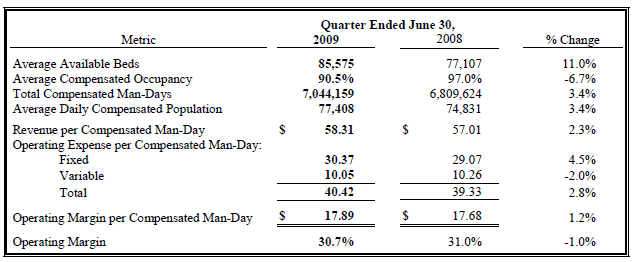
Total operating expenses per compensated man-day increased 2.8% during the second quarter of 2009 compared with the same period in 2008. A significant component of the increase in operating costs per man-day was due to staffing expenses incurred in anticipation of receiving inmates at our Adams County facility from the BOP and at our La Palma and Tallahatchie facilities from the state of California. From March 31, 2009 to June 30, 2009 our state of California inmate populations increased from 6,647 to 7,884. Also impacting the increase in operating expenses were operational inefficiencies associated with our inventory of available beds.
We expect fixed costs per compensated man-day to continue to be negatively impacted by ramp-up expenses at our Adams County Correctional Center and the North Georgia Detention Center as we continue to prepare for the commencement of operations at these facilities.
Business Development Update
In July 2009, CCA was selected for the continued management of the 893-bed Lake City Correctional Facility in Lake City, Florida. The Department of Management Services for the state of Florida solicited competitive bids to manage the Lake City facility. The new contract was effective July 31, 2009 and expires June 30, 2012, with an indefinite number of two-year renewal options.
Also in July 2009, we announced that we were awarded an amendment to our existing contracts with the Georgia Department of Corrections to expand two of our existing facilities by 1,500 beds. The award satisfied a competitive Request for Proposal of 1,500 beds from the state of Georgia that was issued in October of 2008. We currently house approximately 3,400 inmates from the state of Georgia. As a result of the award, we will expand our 1,524-bed Coffee Correctional Facility by 788 beds and our 1,524-bed Wheeler Correctional Facility by 712 beds. The expansions are estimated to cost $65.0 million and are currently anticipated to be completed during the third quarter of 2010, at which point we expect to begin receiving the incremental inmates. The amended contract expires June 30, 2010 and includes twenty-four one-year remaining renewal options. In addition to the occupancy guarantee on the existing beds at both facilities, the amended contract contains a 90% guarantee on the expansion beds.
In April 2009, we announced that we were awarded a contract with the BOP to house up to 2,567 federal inmates at our recently completed 2,232-bed Adams County Correctional Center in Mississippi. The four-year contract, awarded as part of the Criminal Alien Requirement 8 Solicitation ("CAR 8"), also provides for up to three two-year renewal options and includes contract provisions that are materially comparable to our other contracts with the BOP, including a 50% guarantee of occupancy during the activation period and a 90% guarantee thereafter. In July 2009, we received a Notice to Proceed, the final procedure in the federal contract award process, from the BOP to begin performance of services at the Adams County facility. As anticipated, we began receiving inmates on August 3, 2009.
In March 2009, we announced a new contract to manage detainee populations for ICE at the North Georgia Detention Center in Hall County, Georgia with a total design capacity of 502 beds upon completion of renovations. Under a five-year Inter-Governmental Service Agreement between Hall County, Georgia and ICE, we will house up to 500 ICE detainees at the facility. We are leasing the former Hall County Jail from Hall County, Georgia. The lease has an initial term of 20 years with two five-year renewal options and provides us the ability to cancel the lease if we do not have a management contract. We currently anticipate opening the facility during the third quarter of 2009 and expect the facility to ramp through the first quarter of 2010.
Update on California
On Tuesday, August 4, 2009, a panel of three federal judges issued an order requiring the state of California to develop a plan of action within 45 days for reducing its inmate population to within 137.5% of capacity in the next two years. This targeted occupancy is within the range previously discussed by the three-judge panel and, if implemented would require that California's total current population be reduced by approximately 40,000 inmates. In commenting on the order, the Secretary of the California Department of Corrections and Rehabilitation stated that the administration will appeal any cap on inmate populations imposed by the three-judge panel. He also stated that the use of out-of-state beds is a good partial solution to the overcrowding situation and that the state may need to expand its use of out of state beds beyond the 8,000 beds currently under contract.
Liquidity Update
Capital Resources
At June 30, 2009, our liquidity was provided by cash on hand of $73.4 million and $188.0 million available under our revolving credit facility. On July 3, 2009, we redeemed the remaining $77.9 million of the 7.5% senior notes outstanding at June 30, 2009. We believe we have the ability to fund our capital expenditure requirements, working capital and debt service requirements, with cash on hand, net cash provided by operations, and borrowings available under our revolving credit facility. None of our outstanding debt requires scheduled principal repayments, and we have no debt maturities until December 2012.
Guidance
We expect EPS for the third quarter of 2009 to be in the range of $0.30 to $0.32 and fourth quarter of 2009 EPS to be in the range of $0.32 to $0.35, resulting in full year 2009 EPS to be in the range of $1.21 to $1.26, excluding expenses associated with debt refinancing transactions.
Nearly all of our state customers have finalized their fiscal year 2010 budgets. However, uncertainty remains around the economic downturn and the potential impacts on state budgets going forward. Our earnings guidance incorporates our best estimate of the range of potential outcomes related to state budget uncertainties and other variables, including the risk of population declines from certain customers and the potential for additional pricing pressure. We believe the long-term growth opportunities of our business remain very attractive as insufficient bed development by our customers should result in a continuation of the supply and demand imbalance that has been benefiting the private corrections industry.
During 2009, we expect to invest approximately $145.1 million in capital expenditures, consisting of approximately $92.1 million in prison construction and expansions that have been previously announced, $39.3 million in maintenance capital expenditures and $13.7 million in information technology. We also expect a 2009 GAAP income tax rate of approximately 38%, with cash taxes expected to approximate $80.0 million to $85.0 million.
Supplemental Financial Information and Investor Presentations
We have made available on our website supplemental financial information and other data for the second quarter of 2009. We do not undertake any obligation, and disclaim any duty, to update any of the information disclosed in this report. Interested parties may access this information through our website at www.correctionscorp.com under "Financial Information" of the Investor section.
Management may meet with investors from time to time during the third quarter of 2009. Written materials used in the investor presentations will also be available on our website beginning on or about August 21, 2009. Interested parties may access this information through our website at www.correctionscorp.com under "Webcasts" of the Investor section.
Webcast and Replay Information
We will host a webcast conference call at 10:00 a.m. central time (11:00 a.m. eastern time) tomorrow, August 6, 2009, to discuss our second quarter 2009 financial results. To listen to this discussion, please access "Webcasts" on the Investor page at www.correctionscorp.com. The conference call will be archived on our website following the completion of the call. In addition, a telephonic replay will be available at 6:00 p.m. eastern time on August 6, 2009 through 11:59 p.m. eastern time on August 13, 2009, by dialing 888-203-1112, pass code 3280584.
About CCA
CCA is the nation's largest owner and operator of privatized correctional and detention facilities and one of the largest prison operators in the United States, behind only the federal government and three states. We currently operate 65 facilities, including 44 company-owned facilities, with a total design capacity of approximately 86,500 beds in 19 states and the District of Columbia. We specialize in owning, operating and managing prisons and other correctional facilities and providing inmate residential and prisoner transportation services for governmental agencies. In addition to providing the fundamental residential services relating to inmates, our facilities offer a variety of rehabilitation and educational programs, including basic education, religious services, life skills and employment training and substance abuse treatment. These services are intended to reduce recidivism and to prepare inmates for their successful re-entry into society upon their release. We also provide health care (including medical, dental and psychiatric services), food services and work and recreational programs.
Forward-Looking Statements
This press release contains statements as to our beliefs and expectations of the outcome of future events that are forward-looking statements as defined within the meaning of the Private Securities Litigation Reform Act of 1995. These forward-looking statements are subject to risks and uncertainties that could cause actual results to differ materially from the statements made. These include, but are not limited to, the risks and uncertainties associated with: (i) general economic and market conditions, including the impact governmental budgets can have on our per diem rates and occupancy; (ii) fluctuations in our operating results because of, among other things, changes in occupancy levels, competition, increases in cost of operations, fluctuations in interest rates and risks of operations; (iii) our ability to obtain and maintain correctional facility management contracts, including as a result of sufficient governmental appropriations and as a result of inmate disturbances; (iv) changes in the privatization of the corrections and detention industry, the public acceptance of our services, the timing of the opening of and demand for new prison facilities and the commencement of new management contracts; (v) risks associated with judicial challenges regarding the transfer of California inmates to out of state private correctional facilities; and (vi) increases in costs to construct or expand correctional facilities that exceed original estimates, or the inability to complete such projects on schedule as a result of various factors, many of which are beyond our control, such as weather, labor conditions and material shortages, resulting in increased construction costs. Other factors that could cause operating and financial results to differ are described in the filings made from time to time by us with the Securities and Exchange Commission.
CCA takes no responsibility for updating the information contained in this press release following the date hereof to reflect events or circumstances occurring after the date hereof or the occurrence of unanticipated events or for any changes or modifications made to this press release.
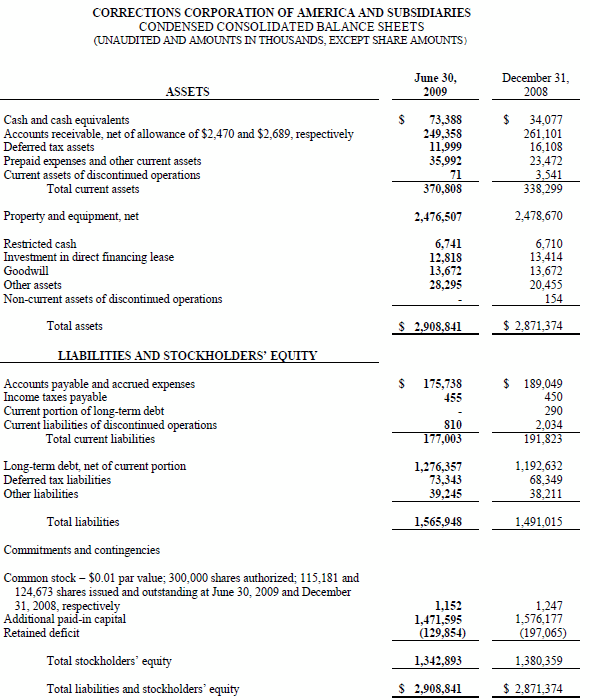
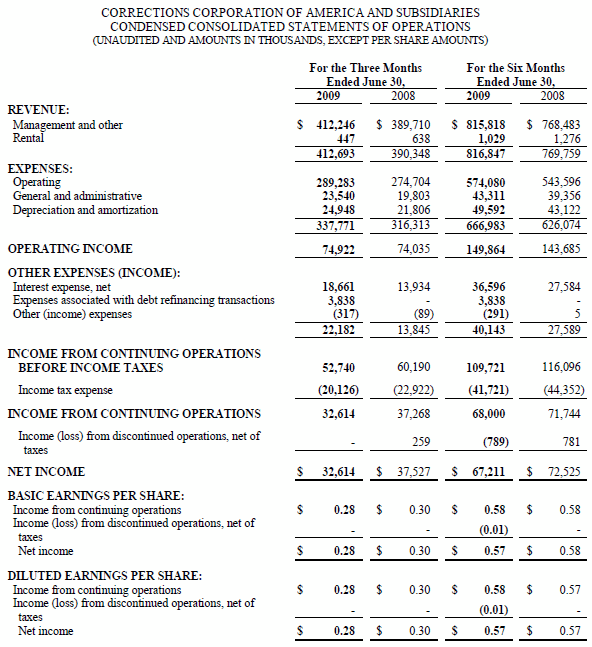
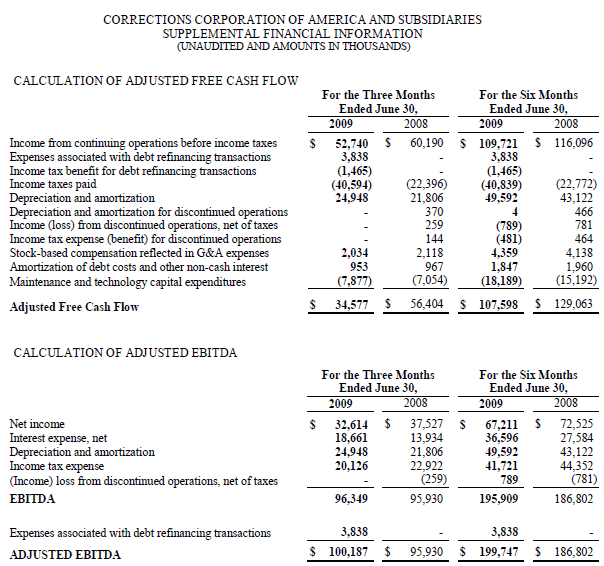
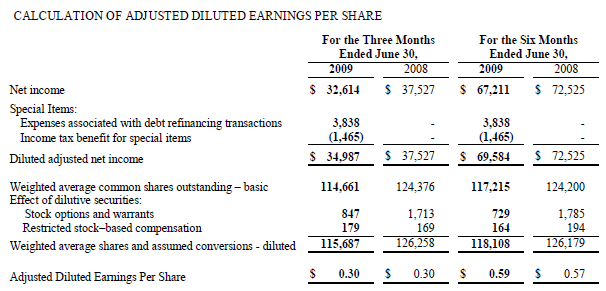
NOTE TO SUPPLEMENTAL FINANCIAL INFORMATION
Adjusted Diluted Earnings Per Share (Adjusted EPS), EBITDA, Adjusted EBITDA and Adjusted Free Cash Flow are non-GAAP financial measures. The Company believes that these measures are important operating measures that supplement discussion and analysis of the Company's results of operations and are used to review and assess operating performance of the Company and its correctional facilities and their management teams. The Company believes that it is useful to provide investors, lenders and security analysts disclosures of its results of operations on the same basis as that used by management.
Management and investors review both the Company's overall performance (including GAAP EPS, net income, Adjusted EPS and Adjusted Free Cash Flow) and the operating performance of the Company's correctional facilities (EBITDA and Adjusted EBITDA). EBITDA and Adjusted EBITDA are useful as supplemental measures of the performance of the Company's correctional facilities because they do not take into account depreciation and amortization, tax provisions, or with respect to Adjusted EBITDA, the impact of the Company's financing strategies. Because the historical cost accounting convention used for real estate assets requires depreciation (except on land), this accounting presentation assumes that the value of real estate assets diminishes at a level rate over time. Because of the unique structure, design and use of the Company's correctional facilities, management believes that assessing performance of the Company's correctional facilities without the impact of depreciation or amortization is useful. The calculation of Adjusted Free Cash Flow substitutes capital expenditures incurred to maintain the functionality and condition of the Company's correctional facilities in lieu of a provision for depreciation; Adjusted Free Cash Flow also excludes certain other non-cash expenses that do not affect the Company's ability to service debt.
The Company may make adjustments to GAAP net income, Adjusted EBITDA and Adjusted Free Cash Flow from time to time for certain other income and expenses that it considers non-recurring, infrequent or unusual, such as the special charges in the preceding calculation of Adjusted Diluted Earnings Per Share, even though such items may require cash settlement, because such items do not reflect a necessary component of the ongoing operations of the Company. Other companies may calculate Adjusted EPS, EBITDA, Adjusted EBITDA and Adjusted Free Cash Flow differently than the Company does, or adjust for other items, and therefore comparability may be limited. Adjusted EPS, EBITDA, Adjusted EBITDA and Adjusted Free Cash Flow are not measures of performance under GAAP, and should not be considered as an alternative to cash flows from operating activities, a measure of liquidity or an alternative to net income as indicators of the Company's operating performance or any other measure of performance derived in accordance with GAAP. This data should be read in conjunction with the Company's consolidated financial statements and related notes included in its filings with the Securities and Exchange Commission.
Contact: Investors and Analysts: Karin Demler, CCA at (615) 263-3005
Financial Media: David Gutierrez, Dresner Corporate Services at (312) 780-7204
